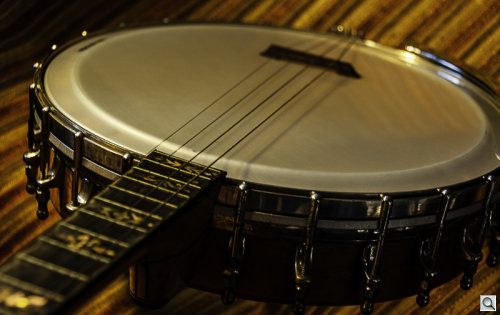Photo Corners headlinesarchivemikepasini.com
![]()
A S C R A P B O O K O F S O L U T I O N S F O R T H E P H O T O G R A P H E R
![]()
Enhancing the enjoyment of taking pictures with news that matters, features that entertain and images that delight. Published frequently.
Friday Slide Show: Orpheum Tenor Banjo



10 April 2020
Several weeks ago Mom couldn't find her small black Sony transistor radio. Since it's her constant companion, she was distraught. We looked everywhere before conceding the obvious and driving over to Best Buy to get her a new one.
But during our search for the little thing, we dove under one of the beds and found a banjo case.
We recognized it. It had belonged to our grandfather, who acquired it early in the 20th century after World War I. He had passed it on to us in the 1960s when we were in high school and we had replaced the deteriorated skin head with a WeatherKing weatherproof head.
We never learned to play it but a younger brother did and he would earn a penny or two playing at Ghirardelli Square wearing garters on his sleeves when he was in high school.
We hadn't seen it since then. So when we opened the case, it was a little like exhuming a body.
The Orpheum was made by Rettburg and Lange in New York City. This particular model had the serial number 06750, dating it to 1918.
It has four strings which can be tuned as tenor (C G D A) or Irish tenor (G D A E) with heavier strings. The rim is maple as is the neck with a 17-fret bound pearwood fingerboard with pearl inlays and mechanical friction tuners with ivoroid buttons. The Orpheum tone ring is intact.
Here's what it sounds like:
Appraisal varies on condition and with a broken but repaired neck, that's an issue. But we'd recommending insuring it for $800 to $1,000 if we were one of those charming appraisers on Antiques Roadshow.
Shooting it was an adventure. We tried three different approaches.
First we shot it on a dark background using LED lights and a Lensbaby Edge 80 in macro mode.
Then we tried shooting it with the same lens but changing to a brighter strobe using a warm filter through an egg crate adapter to focus the light in a tighter beam.
Finally, we propped it up on our grandfather's chair, turned on a couple of 60-watt warm compact fluorescents and fired away with an 18-200mm Nikkor.
The first approach suffered from camera motion at slow shutter speeds despite the LED lighting. The second set was intriguing but not quite the ticket, although it did convince us that some theatrical lighting would enhance the show.
So we warmed up the chair shots after setting them all to Adobe Vivid color and liked what we saw. It sort of echoed the brassy sound of the heavy music maker.
All the metal, the ebony inlaid fingerboard and the plastic head might make you think cool tones would have been best but the maple just screamed to be heard. So going warm instead of cool brought the instrument to life.
We gave it a strum or two before returning it to its case. And in a day or two we'll probably slide it back under the bed. And go see what Mom's listening to on the radio.
